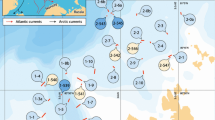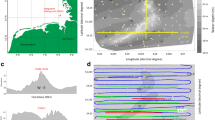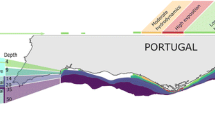Abstract
The MAREANO (Marine AREA database for NOrwegian coast and sea areas) mapping programme includes acquisition of multibeam bathymetry and backscatter data together with a comprehensive, integrated biological and geological sampling programme. Equipment used includes underwater video, box corer, grab, epibenthic sled and beam trawl. Habitat maps are produced by combining information on landscapes, landscape elements, sediment types and biological communities. Video observations provide information about the megafauna diversity of large (>1 cm) epifauna and bottom types, whilst bottom samples describe the composition of epifauna, hyperfauna (crustaceans living in the upper part of the sediment and/or swimming just above the substratum) and infauna, and sediment composition. In this study, two biological data sets are used to study fauna response to environmental heterogeneity at two different spatial scales: (1) broad scale, megahabitat (1–10s km), based on information about megafauna taxa observed during video surveys in the Nordland/Troms area, (2) fine scale, mesohabitat (10s m−1 km), based on information about species composition documented with video records and bottom sampling gear from the bank “Tromsøflaket”. In general, the highest diversity is found on bottoms with mixed substrates indicating that substratum heterogeneity is very important for the biodiversity at both scales. The number of taxa shows a maximum at depths between 200 and 700 m followed by a gradual decrease down to 2,200 m. At the broad scale, multibeam data provides a variety of terrain variables that indicate environmental variation (e.g. exposure to currents, interpreted substrates). This analysis identifies six fauna groups associated to specific landscape elements. Diversity of megafauna shows a strong correlation with number of bottom types occurring along video transects. It is highest at the shelf break and decreased with depth on the slope in parallel with a decrease in habitat heterogeneity and temperature. At a fine scale, six biotopes are identified based on megafauna composition with habitat characteristics ranging from homogenous muddy bottom, biotope 1, to the most heterogeneous bottom with >20% rocks and several bottom types present in biotope 6. The macrofauna sampled is used for description of the whole benthic community, including diversity, biomass and production, related to these six biotopes. The variation in percentage cover of substrate types and in particular the cover of hard substrates demonstrate to be a good proxy for the benthic community composition (mega- and macrofauna) and its diversity.
















Similar content being viewed by others
References
Babichenko, S., P. Wassmann, L. Poryvkina & I. Andreassen, 1999. Small time and spatial scale variability of phytoplankton distribution on the north Norwegian shelf in 1995. Sarsia 84: 293–302.
Barnett, V. & T. Lewis, 1994. Outliers in statistical data, 3rd ed. Wiley, New York.
Bellec, V., M. F. J. Wilson, R. Bøe, L. Rise, T. Thorsnes, L. Buhl-Mortensen, P. Buhl-Mortensen, 2008. Bottom currents interpreted from iceberg ploughmarks revealed by multibeam data at Tromsøflaket, Barents Sea. Mar Geol 249:257–270.
Berge, J. & W. Vader, 2001. Revision of the amphipod (Crustacea) family Stegocephalidae. Zoological Journal of the Linnean Society 133(4): 531–592.
Bergman, M. J. N, S. N. R Birchenough, Á. Borja, S. E. Boyd, C. J. Brown, L. Buhl-Mortensen, R. Callaway, D. W. Connor, K. M. Cooper, J. Davieas , I. De Boois, K. D. Gilkinson, D. C. Gordon Jr., H. Hillewaert, H. Kautski, M. De Kluyver, I. Kröncke , D. S. Limpenny, W. J. Meadows, S. Parra, S. E. Pennington, E. Rachor, H. L. Rees, H. Reiss, H. M. Rumohr, Schratzberger, S. Smith, B. G. Tunberg, J. A. Van Dalfsen, S. Ware & L. Watling, 2009. Guidelines for the study of the epibenthos of subtidal environments. ICES Techniques in Marine Environmental Sciences No. 42. 88 pp
Bett, B. J., 2001. UK Atlantic Margin Environmental Survey: introduction and overview of bathyal benthic ecology. Continental Shelf Research 21: 917–956.
Brey T., 2001. Empirical relations in aquatic populations for estimation of production, productivity, mortality, respiration. Population dynamics in benthic invertebrates. A virtual handbook. Version 01.2, http://www.thomas-brey/science/handbook.
Brey T., 2005. Conversion factors for aquatic organisms. Population dynamics in benthic invertebrates. A virtual handbook. Version 01.2, http://www.thomas-brey/science/handbook.
Buhl-Jensen, L., 1986. The benthic amphipod fauna of the west-Norwegian continental shelf compared with the fauna of five adjacent fjords. Sarsia 71: 193–208.
Buhl-Mortensen, L., 1996. Amphipod fauna along an offshore-fjord gradient. Journal of Natural History 30: 23–49.
Buhl-Mortensen, L., A. Vanreusel, A. J. Gooday, L. A. Levin, I. G. Priede, P. Buhl-Mortensen, H. Gheerardyn, N. J. King & M. Raes, 2010. Biological structures as a source of habitat heterogeneity and biodiversity on the deep ocean margins. Marine Ecology 31(1): 21–50.
Buhl-Mortensen, L., R. Bøe, M. F. J. Dolan, P. Buhl-Mortensen, T. Thorsnes, S. Elvenes & H. Hodnesdal, 2012. Ch. 51: banks, troughs and canyons on the continental margin off Lofoten, Vesterålen, and Troms, Norway.
Dahl, E., L. Laubier, M. Sibuet & J.-O. Strömberg, 1976. Some quantitative results on benthic communities of the deep Norwegian Sea. Astarte 9: 61–79.
Davies C. E., D. Moss & M. O. Hill (2004). EUNIS Habitat Classification Revised 2004. Report to the European Topic Centre on Nature Protection and Biodiversity, European Environment Agency. Available online at http://eunis.eea.eu.int/eunis/habitats.jsp).
Dolan, M. F. J., P. Buhl-Mortensen, T. Thorsnes, L. Buhl-Mortensen, V. K. Bellec & R. Bøe, 2009. Developing seabed nature-type maps offshore Norway: initial results from the MAREANO programme. Norwegian Journal of Geology 89: 17–28.
Doyle, R. W., 1975. Settlement of planktonic larvae: a theory of habitat selection in varying environments. American Naturalist 109: 113–126.
Enequist, P., 1949. Studies on the soft-bottom amphipods of the Skagerak. Almqvist & Wiksells, Uppsala.
Etter, R. J. & J. F. Grassle, 1992. Patterns of species diversity in the deep sea as a function of sediment particle size diversity. Nature 360: 576–578.
Fauchald, K. & P. A. Jumars, 1979. The diet of worms: a study of polychaete feeding guilds. Oceanography and Marine Biology: An Annual Review 17: 193–284.
Ferrini, V. L. & R. D. Flood, 2006. The effects of fine-scale surface roughness and grain size on 300 kHz multibeam backscatter intensity in sandy marine sedimentary environments. Marine Geology 228(1–4): 153–172.
Gage, J. D., 2001. Deep-sea benthic community and environmental impact assessment at the Atlantic Frontier. Continental Shelf Research 21: 957–986.
Golding N., M. A. Vincent & D. W. Connor, 2004. Irish Sea Pilot – Report on the development of a Marine Landscape classification for the Irish Sea, JNCC. (www.jncc.gov.uk/irishseapilot).
Greene, H. G., M. M. Yoklavich, R. M. Starr, V. M. O’Connell, W. W. Wakefield, D. E. Sullivan, J. E. McRea Jr & G. M. Cailliet, 1999. A classification scheme for deep seafloor habitats. Oceanologica Acta 22: 663–678.
Hansen, B. & S. Østerhus, 2000. North Atlantic-Nordic Seas exchanges. Progress in Oceanography 45: 109–208.
Holte, B., 1998. The macrofauna and main functional interactions in the sill basin sediments of the pristine Holandsfjord, northern Norway, with autecological reviews for some key-species. Sarsia 83: 55–68.
Holte B., 2004. The benthic macrofauna in North Norwegian and Svalbard fjord sediments, Tromsø.
Holte, B., E. Oug & S. Cochrane, 2004. Depth-related benthic macrofaunal biodiversity patterns in three undisturbed north Norwegian fjords. Sarsia 89: 91–101.
Hughes Clarke J. E., B. W. Danforth & P. Valentine, 1997. Areal seabed classification using backscatter angular response at 95 kHz. Shallow Water, NATO SACLANTCEN, conference proceedings series CP-45, pp 243–250.
Hurlbert, S. H., 1971. The nonconcept of species diversity: a critique and alternative parameters. Ecology 52: 577–586.
Jumars, P. A., 1975. Environmental grain and polychaete species diversity in a bathyal benthic community. Marine Biology 30: 253–266.
Klitgaard-Kristensen, D. & L. Buhl-Mortensen, 1999. Benthic foraminifera along an offshore-fjord gradient: a comparison with amphipods and molluscs. Journal of Natural History 33: 317–350.
Lincoln, R. J., 1979. British marine Amphipoda: Gammaridea. British Museum of Natural History, London.
MacArthur, R. H. & E. O. Wilson, 1967. The Theory of Island Biogeography. Princeton University Press, Princeton: 224 pp.
Magurran, A. E., 2004. Measuring biological diversity. Blackwell Publishing, Oxford.
Mokievsky, V. O., 2009. Marine protected areas: theoretical background for design and operation. Russian Journal of Marine Biology 35(6): 504–514.
Mortensen, P. B. & L. Buhl-Mortensen, 2005. Coral habitats in the Gully, a submarine canyon off Atlantic Canada. In Freiwald, A. & J. M. Roberts (eds), Cold-water corals and ecosystems. Springer-Verlag, Berlin, Heidelberg: 247–277.
Mortensen, P. B., L. Buhl-Mortensen, M. Dolan, J. Dannheim & K. Kröger, 2009a. Megafaunal diversity associated with marine landscapes of northern Norway: a preliminary assessment. Norwegian Journal of Geology 89: 163–171.
Mortensen P. B., M. F. J. Dolan & L. Buhl-Mortensen, 2009b. Prediction of habitats on a fishing bank off Northern Norway using a combination of multivariate analysis and GIS classification. ICES Journal of Marine Science. doi:10.1093/icesjms/fsp200.
Naylor E., 1972. British marine isopods. Keys and notes for the identification of the species. Synopses of the British Fauna N.S. No. 3. Academic Press, New York.
Nitsche, F. O., R. Bell, S. M. Carbotte, W. B. F. Ryan & R. Flood, 2004. Process-related classification of acoustic data from the Hudson River Estuary. Marine Geology 209(1–4): 131–145.
Pielou, E. C., 1966. The measurement of diversity in different types of biological collections. Journal of Theoretical Biology 13: 131–144.
Pineda, J., 2000. Linking larval settlement to larval transport: assumptions, potentials, and pitfalls. Oceanography of the Eastern Pacific I(2000): 84–105.
Roff, J. C. & M. E. Taylor, 2000. Viewpoint; National frameworks for marine conservation – a hierarchical geophysical approach. Aquatic Conservation; Marine and Freshwater Ecosystems 10: 209–223.
Rothlisberg, P. C. & W. G. Pearcy, 1977. An epibenthic sampler used to study the ontogeny of vertical migration of Pandalus jordani (Decapoda, Caridea). Fishery Bulletin, National Oceanic and Atmospheric Administration of the United States 74: 994–997.
Shannon, C. E. & W. Weaver, 1949. The mathematical theory of communication. University of Illinois Press, Urbana: 117 pp.
Simberloff D. S., 1978. Use of rarefaction and related methods in ecology. In Dickson K. L., J. Cairns Jr. & R. J. Livingston (eds), Biological Data in Water Pollution Assessment: Quantitative and Statistical Analyses. American Society for Testing and Materials STP 652, Philadelphia: 150–165.
Soetaert, K. & C. Heip, 1990. Sample-size dependence of diversity indices and the determination of sufficient sample size in a high-diversity deep-sea environment. Marine Ecology Progress Series 59: 305–307.
Tews, J., U. Brose, V. Grimm, K. Tielbörger, M. C. Wichmann, M. Schwager & F. Jeltsch, 2004. Animal species diversity driven by habitat heterogeneity/diversity: the importance of keystone structures. Journal of Biogeography 31: 79–92.
Thorsnes, T., L. Erikstad, M. F. J. Dolan & V. K. Bellec, 2009. Submarine landscapes along the Lofoten–Vesterålen–Senja margin, northern Norway. Norwegian Journal of Geology 89: 5–16.
Wentworth, C. K., 1922. A scale of grade and class terms for clastic sediments. Journal of Geology 30: 377–392.
Whittaker, R. J., K. J. Willis & R. Field, 2001. Scale and species richness: towards a general hierarchical theory of species diversity. Journal of Biogeography 28: 453–470.
Williams, A. et al., 2010. Scales of habitat heterogeneity and megabenthos biodiversity on an extensive Australian continental margin (100–1000 m depths). Marine Ecology 31: 222–236.
Wilson, M. F. J., B. O’ Connell, C. Brown, J. C. Guinan & A. J. Grehan, 2007. Multiscale terrain analysis of multibeam bathymetry data for habitat mapping on the continental slope. Marine Geodesy 30: 3–35.
Acknowledgments
This article is a product of the MAREANO programme (www.mareano.no) financed by the Norwegian government. The authors would like to thank all MAREANO partners, cruise participants, and the crew onboard RV G. O. Sars for their contributions to this study. The authors are indebted to several anonymous reviewers for improving the manuscript.
Author information
Authors and Affiliations
Corresponding author
Additional information
Guest editors: K. E. Kovalenko & S. M. Thomaz / The importance of habitat complexity in waterscapes
Electronic supplementary material
Below is the link to the electronic supplementary material.
Rights and permissions
About this article
Cite this article
Buhl-Mortensen, L., Buhl-Mortensen, P., Dolan, M.F.J. et al. Habitat complexity and bottom fauna composition at different scales on the continental shelf and slope of northern Norway. Hydrobiologia 685, 191–219 (2012). https://doi.org/10.1007/s10750-011-0988-6
Received:
Accepted:
Published:
Issue Date:
DOI: https://doi.org/10.1007/s10750-011-0988-6




